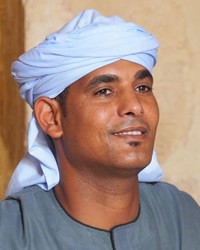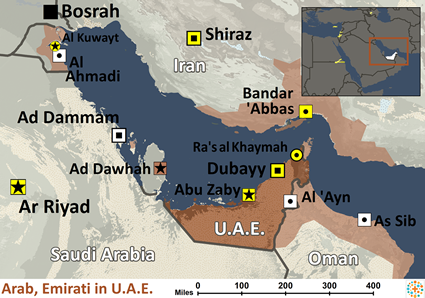Arab culture was developed by tribes of nomads and villagers living in the Arabian Desert. They migrated throughout the Middle East and northern Africa, leading to the expansion of the Arab world. Today, the region is home to a number of different types of Arabs. Gulf Arabs (also known as Saudi Arabs) live primarily along the southern edges of the Arabian Desert. They speak Arabiya, or, as it is commonly known, Gulf Arabic.
Gulf Arabs in the UAE are called Emiratis and share a Bedouin heritage. Since the oil boom of the 1950s, their lifestyles have changed drastically. The sheiks and their families are extremely wealthy, making their livings in international business and high government positions. Many elements of their material lifestyles are Western. Other Emiratis, however, depend on the welfare system. They choose not to work and often refuse to take advantage of free higher education.
As the economy of the UAE boomed, large numbers of expatriates were imported. Only a small percentage of the population is now Emirati. The rest is composed of people from South Asia (Indian, Pakistani, Bangladeshi and Nepali), other Arab nations, and the West. These immigrants do not generally hold citizenship. UAE society is one of the most diverse in the world, with workers from over 200 countries.
Dairy products have been the traditional food source of the Gulf Arabs. They once drank fresh camel and goat milk and made it into yogurt and clarified butter (ghee). Round loaves of unleavened bread were also eaten. Dessert after a meal would often consist of dates, which can be found in desert oases. Meat was traditionally eaten only on special occasions such as wedding feasts, ceremonies, or when entertaining guests. Though modern Emiratis still value these traditional foods, their diets have become cosmopolitan and diverse.
Despite the influence of wealth and Western culture, many Emirati customs and values continue. For instance, in accordance with their Muslim religion, Gulf Arab marriages are typically endogamous (they only marry within a small social circle). The government discourages marrying a non-Emirati. Inheritance is patrilineal (passed down from fathers to their sons). Gulf Arab clothing remains traditional, designed for the harsh desert climate. It is made of lightweight, light-colored fabric and is loose-fitting, allowing for the circulation of air.
With the influx of immigrants to the UAE and the rapid changes in society, Emiratis have felt a strong need to preserve their traditional culture and values. Falconing, camel races, camel beauty contests and winter camping trips to the desert are national pastimes. Emiratis still have a high value for generosity and hospitality. With the exception of a few Bedouins, Emiratis no longer live in tents or make their living from camels, sheep or cattle.
Approximately half of the Gulf Arabs are Shafi'ite Muslim. Some are Hanbalite (Wahhabite) Muslims. Others are Malikite Muslims. As Muslims, they follow the teachings of the prophet Mohammed. They believe that the only way to God is through following the teachings of their holy book, the Koran. Their religion is one of works based on these five "pillars": (1) A Muslim must affirm that "there is no god but Allah, and Mohammed is his prophet." (2) Five times a day, he must pray while facing Mecca. (3) He must give an obligatory percentage (very similar to tithes) on an annual basis. (4) He must fast during Ramadan, the ninth month of the Muslim year. (5) He must try to go on a pilgrimage to Mecca at least once in his lifetime. Alongside their Islamic faith, wealth and westernization have also gained a role in the lives of many Emiratis. As a nation, the UAE has taken a moderate view toward Islam and allows people of other faiths, including Hindus and Christians, to worship freely.
A profession of faith in Jesus could cost an Emirati his family, his honor, his job, or even his life. Evangelization of this people group will be challenging due to the nature of the Arab lifestyle and belief system.
Ask the Lord of the harvest to open the region's doors to preaching the gospel.
Ask the Holy Spirit to call people willing to share Christ's love with Gulf Arabs.
Ask God to raise up prayer teams who will begin breaking up the soil through worship and intercession.
Pray for a movement of Gulf Arabs calling on the name of Jesus.
Scripture Prayers for the Arab, Emirati in United Arab Emirates.
| Profile Source: Joshua Project |


























